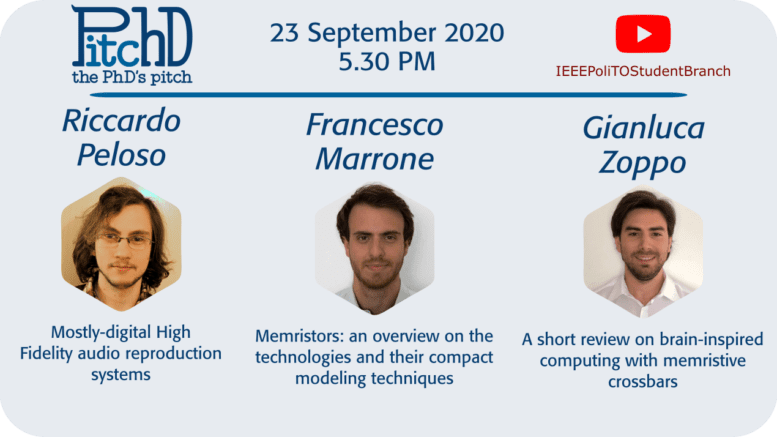YouTube Live Broadcast
Here’s the 6th PitchD – the PhD’s pitch. Our PhD IEEE Student Members explain to students, colleagues and professors their research.
Mostly-digital High Fidelity audio reproduction systems
Mr. Riccardo Peloso
Dept. of Electronics and Telecommunications (DET), Politecnico di Torino
Recent years have observed a significant rise in popularity of music streaming services. Instead of using a physical format, music is now distributed in a completely digital way. Nevertheless, on the playback phase little has changed as it remained inherently analog. It follows that to correctly reproduce a digital audio signal, it must be converted back to its analog representation. This operation has to be performed by a Digital to Analog Converter (DAC). During the conversion phase digital signals are subject to inevitable analog errors which can deteriorate the quality of the resulting output signal. In High Fidelity audio systems, which aim to be as faithful as possible to the original source, these kind of errors represent a major obstacle to overcome. Although older analog-centric DAC chips are able to partially mitigate this issue, newer digital-centric designs struggle to reach the same level of performance, as they need to cope with error related to modern transistor production processes.This talk will focus on novel smart digital algorithms capable of concealing and mitigating issues related to digital-centric DACs, while keeping cost and power consumption low.
Memristors: an overview on the technologies and their compact modeling techniques
Mr. Francesco Marrone
Dept. of Electronics and Telecommunications (DET), Politecnico di Torino
In the last decade, the accelerating progress in the development of more and more complex neural networks has called for performant accelerators and novel computing paradigms. Memristors, theorized to be the fourth fundamental circuit elements, have attracted the interest of the neuromorphic computing research community as promising technologies to overcome the limitations of current digital systems. Originally developed as information storage devices, memristive technologies have unvealed their true potential as basic computing elements by exploiting the Ohm’s Law when operated at very low electric field. Nonetheless, their intriguing complex physical working principles, responsible for their state-dependent highly nonlinear characteristics, open the door to very novel computing paradigms such as spiking and oscillatory neural networks. Those complex physical phenomena, which qualify memristors as perfect candidates for mimicking neuron level activities, need either very powerful computers to be simulated or application specific compact modelling techniques.
A short review on brain-inspired computing with memristive crossbars
Mr. Gianluca Zoppo
Dept. of Electronics and Telecommunications (DET), Politecnico di Torino
Most conventional artificial neural networks architectures are implemented on digital computers yielding order of magnitude higher energy consumption than biological brains. Neuromorphic computing aims to emulate the neural structure and operation of the brain in order to create low power computing platforms that are able to tackle complex tasks in artificial intelligence. Nonvolatile memory devices, such as memristors, stand out as promising candidates to represent synaptic weights of artificial neural networks by enabling efficient parallel computations such as matrix-vector multiplications. Despite the great success in deep learning applications, there is an increasing interest in the direct use of the intrinsic physics dynamics of these devices in approximating the complex behavior of the brain. Various short/long-term synaptic plasticities have been recently reported and the analysis of the analog neural networks dynamics has drawn particular interest among researchers. This talk will briefly introduce different applications of memristive crossbars both as accelerators for deep learning and as building blocks for analog neural networks.


Be the first to comment on "PitchD 2020 edition: the 6th PitchD [ONLINE]"